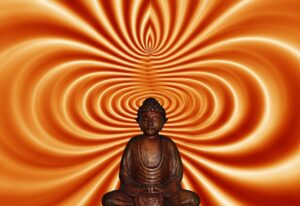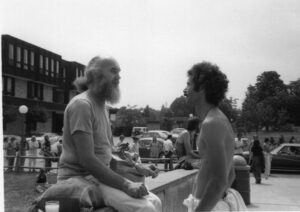Why do some people like to ponder, while others love to socialize? Why is the introvert so good at math, while the extravert is so good with people? Is there a way that we can combine the good parts of both the Introvert and the Extravert, to become — something never seen before on the face of the Earth — a Supervert?!?
Become a Supervert! Transcend Introversion & Extraversion Through Meditation
Why do some people like to ponder, while others love to socialize? Why is the introvert so good at math, while the extravert is so good with people?
Is there a way that we can combine the good parts of both the Introvert and the Extravert, to become — something never seen before on the face of the Earth — a Supervert?!?
When most people in our society (even psychologists) talk about “introversion” and “extraversion,” they tend to look only at the surface behaviors, and are often completely unaware of the underlying causes. This type of understanding only allows us to label “introverts” and “extraverts,” but doesn’t give us any power to switch from one to the other if we want to.
Lucky for you, through meditation, the underlying cause of introversion and extraversion becomes blatantly obvious. Once you understand the choices you are unconsciously making that are causing you to sometimes feel “introverted” and sometimes feel “extraverted,” you will gain the ability to easily switch between introversion and extraversion at will. After a little bit of practice, your brain will just automatically switch to the most useful mode for any given situation!
So How Does Introversion and Extraversion WORK?
Focus…
In the western paradigm of psychology, there are many different theories about why some people are more introverted while some people are more extraverted. The one thing that the scientific research has consistently shown is that extraverts tend to be happier than introverts. Go figure.
When most people think about the concepts of introvert and extravert, they immediately associate them with peoples’ social personas. The introvert is the nerd who likes to study snails in his room and is afraid of social interaction (let’s call him Melvin for now); the extravert is the socialite who loves partying and always needs to be around other people (Angelina). However, if you want to understand what actually causes these complex patterns of behavior, you need to look DEEPER. Warning: deep sh*t ahead.
Carl Jung was one of the deepest psychologists of our time. When he talked about introversion and extraversion, he didn’t talk only about peoples’ social behaviors. He looked deeper.
Why do some people prefer to stay home alone, while other people prefer to go out and socialize? Mr. Jung actually gave a very powerful answer to this question, but I’m afraid most people didn’t understand what he meant, because the way he phrased it sounds… well….
If a person’s psychic energy usually flows outwards then he or she is an extravert, while if the energy usually flows inwards, the person is an introvert. (“The Old Wise Man,” Time magazine article about Jung, Feb. 14, 1955)
… psychic energy? Really? Whenever I read this quote, I can hear Penn Gillette’s unnecessarily loud voice ranting about airy-fairy hippies and new-age pseudo-scientists taking over the world. Come on Carl, couldn’t you have phrased this in a normal way so that people wouldn’t think you were drinking out of beakers you found in Albert Hoffman’s laboratory?
OK, let’s try substituting the word “attention” wherever you see “psychic energy.” Let’s see how this looks.
If a person’s attention usually flows outwards then he or she is an extravert, while if the attention usually flows inwards, the person is an introvert.
Well now, that makes sense!
This is precisely what makes the difference between an introvert and an extravert. In the original Latin, the words “introvert” and “extravert” don’t mean “nerd” and “socialite.” They mean, “one who is turned inward” and “one who is turned outward” (intro = inward, extra = outward, vertere = to turn).
An introvert’s attention is generally turned inward. His attention is usually focused on thoughts, because… well… let’s face it, there’s pretty much nothing else in there. An extravert’s attention is generally turned outward. It is usually focused on physical objects or phenomena that are seen, heard, smelled, tasted, or felt through one of the five senses.
Now, here’s where things start to get really interesting. Now that we understand where the nerds and the socialites are focusing their attention, we can see very clearly how all of their respective behaviors arise!
…becomes behavior!
We can see why our friend Melvin the Introvert would feel uncomfortable and distracted in a noisy room with lots of people (I can’t hear myself think!), while Angelina the Extravert would love to dive into the chaos and explore this type of social gathering (finally some excitement!).
We can see why Melvin would feel at home in a quiet room alone with his thoughts with nothing to distract him, while Angelina might feel bored of staring at the walls all day.
We can see why Melvin would tend to have awkward and/or distant relationships with the people around him (he’s focused on his thoughts, not on the person in front of him), while Angelina connects easily with everybody she meets.
We can see why Melvin likes to talk about science, philosophy, psychology, and politics, while Angelina likes to talk about the people and places around her (that’s what they are constantly focused on, that’s what their worlds are about).
If we dig a little deeper, we can even begin to understand why Angelina’s world is “brighter,” “happier,” and more enjoyable experience than Melvin’s is! *
* This understanding goes very deep, and is beyond the scope of this article. It’s not just about “having more friends,” it’s about stimulation, brain chemicals, and dopamine receptors. Click here if you’d like to read my more in-depths article about Introversion vs. Extraversion.
More to the point, we can see how introversion and extraversion are choices that we make, and how we can easily switch between the two if we want. This is a very powerful thing to understand; it gives you the power to completely change your experience of life whenever you want to.
Change your focus, and your behavior changes magically!
Meditation is an exercise that trains you to use your brain’s “attention control muscles.” In a meditation exercise, you start out by choosing your object of focus, and then you pour all of your “psychic energy” (attention) into it. That’s the whole exercise.
Through meditation, you learn to direct your attention in whichever direction you like, whether it is “inward” or “outward.” You can “introvert” your attention, or you can “extravert” it.
Personally, I grew up as a very extreme introvert (that’s why I have all this interesting thinky-stuff to write on my blog). From the time I was a young child, all the way through the time I started meditating in my third year in University, my attention was constantly turned inward. My experience of life was Melvin’s experience. I didn’t mind being an introvert; in fact, I felt a kind of pride in being an explorer of deep concepts that other people never really thought about. I felt that other people were “shallow,” and I felt no desire to be like that.
When I started meditating, I began to become aware of my “attention control muscles,” in the same way that a person who learns to wiggle his ears becomes aware of the muscles around his ears.
Forgive me, ancient Indian people, I’m going to hijack one of your sacred spiritual symbols for a moment in order to illustrate my point. In this article, let’s use the “Third Eye” as a symbol for “the part of your mind that points and holds your attention in one direction,” the same way that your physical eyes point and hold your vision in one direction.
Imagine there’s a Third Eye in between your two normal eyes, right where your nose meets your forehead. The cool thing about this Super Awesome Eye is that it can spin around like a revolving door, to point inward or outward, or wherever you want it to point! By controlling this eye, you decide where your attention is focused, and the content of your Reality.
Unfortunately, most people don’t even realize that they have control over where this Eye is looking. It just flips back and forth on instinct and habit. The problem is… most of the time, we don’t even realize that we have a Third Eye. We assume that Reality is what we see (and only what we see) at any given moment. Since the eye is constantly shifting from stimulus to stimulus, Reality is constantly changing. This makes life into a great big crazy fun-house of confusion and drama!
This sounds like a crazy way to go through life… and it is. If only we were skilled at controlling the direction of our attention, we would be masters of our own Realities! Unfortunately, each of us has been living with an out-of-control Third Eye, since it began operating on instinct during our first disgusting and traumatic moments, all slimy and bloody in the delivery room.
Children grow up without ever noticing the Third Eye,
A baby’s attention goes wherever there is the “loudest,” most attention-grabbing stimulus. If there is a pretty birdie, the baby’s “Third Eye” will be looking at the pretty birdie (extraverted). If the baby’s stomach is empty, the Third Eye will be looking at the uncomfortable feelings arising in its body, and maybe even some primitive “thoughts” (like “I’m hungry”) that arise in the mind (introverted).
Over time, a child’s Third Eye begins to develop “habits” based on how often its Eye tends to turn inward or outward (check out my article, train your child to be more extraverted or introverted). These habits are actually patterns of behavior, which are encoded in the physical structure of the brain. This is part of the brain’s natural process of change and adaptation, which is called neuroplasticity. I’m not going to get into the physical brain changes right now (read my neuroplasticity article here), so let’s just refer to these behavior patterns as “habits.”
When I was a young’n, for whatever reason (not going to get into it… check out my article, “Psychoanalysis is Useless and Counterproductive”), my Third Eye had developed the habit of looking inward. Over time, this habit grew stronger and stronger, to the point where I could barely even see and hear the world around me. My thoughts were constantly clouding my vision. I unconsciously blocked out sounds so that I could hear myself think. I became… Melvin. Well I never really got into snails but you get the idea.
But we can easily develop our “attention-control muscles” through meditation.
When I first learned to Meditate as a young adult, I began to flex my “attention control muscles” by playing with the direction of my Third Eye. At first it was difficult to turn my Eye away from its usual spot, as it was focused directly on whatever thoughts happened to seem “important” at the time. However, with some effort and determination, I was able to start turning it around intentionally and pointing it at other objects.
At first, the best I could do was to turn my eye from “negative thoughts” to “positive thoughts” and vise versa. This was a very useful thing in itself, as I gained the ability to temporarily cure anxiety attacks and put myself in a “good mood” whenever I wanted to. By doing this, I was also able to turn depression into mania, like water into wine (don’t try this, it’s not sustainable). However, even when it was on “happy thoughts,” the Eye was still directed inward. This ability to turn my attention from negative thoughts to positive thoughts was not a complete paradigm shift, only a new skill to use within my introverted world.
My real paradigm shift came from staring at a tree.
As a young adult, I experienced debilitating social anxiety (part of the introvert complex) and I could barely make eye contact with other people. I downloaded a meditation MP3 that claimed to have the solution to this problem. I started listening, and much to my surprise, the meditation teacher demanded that I sit outside and stare at a tree for an hour.
Feeling a bit odd, I went to my local park (in Long Island City, near the Water Taxi), sat down, and began to stare at a tree. The voice in my headphones told me to let go of my thoughts, and just “Look at the tree, without thinking about it, without thinking about anything. Just look at the tree.” My mind kept wandering into thoughts, like “this is stupid,” “people are staring at me,” “I would get soooo rich if I could figure out a way to invent a teleportation machine like the one in Star Trek,” “I need to call Mindy about the apartment,” stuff like that. But I kept staring at the tree. I was determined to try out this exercise. I didn’t know if it would work or not, but it was worth a try. I brought my attention back to the tree, over and over and over again.
After about half an hour, the voice on the MP3 said something like “I know your mind is probably wandering all over the place, but for this to work, you must keep bringing your attention back to the tree. Imagine that your life depends on it. Imagine that your mother’s life depends on it.”
For some reason, this struck an emotional chord in me. I pushed harder; I began to place more importance on keeping my attention on The Tree than I was placing on each individual thought that arose in my mind.
Gradually, over the next few minutes, an amazing thing started to happen. The tree actually began to come into focus for me. It was as if a grey cloud had been hovering in front of my eyes, and it was now dissolving. For the first time in my adult life, I could see the world around me in beautiful, fluid High Definition. For years I had been watching life on a 13-inch TV screen, and now I was in the IMAX.
As I continued to sit and stare (feeling a bit excited now as my world began to fill with light and color), my vision of the tree became clearer, sharper, and brighter. The colors of the brown bark and the green leaves began to glow with the radiant light of life itself. Everything else began to fade into the background; my thoughts became quieter as my focus honed in on this “external, physical object.” The Third Eye was pointing outward, and was fully focused on something outside of my head for the first time since I was a small child.
I felt a kind of awe, a curiosity, and a love for life itself that I hadn’t felt since I was a child. I was flooded with a kind of intense, overpowering, childlike joy that I hadn’t experienced in many years, a feeling from a half-remembered dream. This joy didn’t stem from “successfully staring at the tree,” and it certainly didn’t stem from any concept or thought that was inside my head.
This joy welled up from a much deeper place. This was the simple joy of being alive, in a world filled with living things. I felt as if this feeling of warmth and joy, this “joie de vivre” was flowing from the fabric of reality itself, the natural state of human existence. It struck me that, for my entire adult life, my chronic internal focus had been the only thing at fault for blocking it out. It was like stepping out into the sunshine after years of sitting in a cave. *
* I believe that the inward vs. outward direction of attention has a direct affect on dopamine levels in the brain, which directly causes extraverts to be happier than introverts. Click here to read my more in-depth article on Focus & Brain Chemistry.
So to sum up, staring at a tree made me feel really good. What was I supposed to be writing about again?
Oh yeah, becoming a Supervert. Right.
There are many different forms of meditation. They vary widely from “watching the breath,” to “walking meditation,” to “body awareness meditation,” to “the men who stare at trees” meditation. You can find detailed instructions for all of these form (and many more) in the “meditation” section of this website.
The one thing that all of these meditation techniques have in common is this: they teach us the skill of attention-control.
The skill of attention control consists of three distinct abilities, each of which is developed through meditation:
1. The ability to notice where your attention (Third Eye) is focused (this ability is called “Mindfulness”),
2. The ability to intentionally turn your Eye in one particular direction (let’s call this “Shifting”), and
3. The ability to hold your Third Eye steady, and stop it from turning chaotically in response to randomly arising stimuli (“Holding”).
No matter what you choose as your object of meditation, these abilities will be trained through your simple act of choosing an object, shifting your full attention to it, and holding it in the light of your attention.
The more you practice meditation, the stronger your attention-control muscles (the muscles that control your Third Eye) become. When you have strong muscles, you don’t need to work hard to perform routine tasks; they just become easier and easier as you get stronger and stronger. This applies to the simple act of switching between introversion and extraversion as well.
During your daily life, you may suddenly become aware that your attention is focused inwardly when it should be focused outwardly (or vise versa). This is your ability of mindfulness, kicking in without you even having to do anything. You then shift your attention outward, and hold your attention on whatever it is that you’re supposed to be focusing on.
At first, you do this with some conscious effort. You marvel at how much more effectively you are able to deal with whatever it is that you were doing. You smile, and pat yourself on the back for a job well done.
Over time, your brain learns through this type of positive reinforcement that you get better results (and thus receive good feelings) by focusing outward, instead of inward (or vise versa) in each particular situation. In this way, your brain forms new habits. You thus become naturally extraverted in situations that call for an extravert, and naturally introverted in situations which are better suited to introverts.
In this way, meditation literally gives you the ability to switch between being introverted and extraverted at will. You will no longer be “Melvin” or “Angelina,” you’ll be Super Melgelina!
However, this does not mean that you will automatically have the knowledge of Stephen Hawking, nor the social skills of Bill Clinton. You will, however, have the power to develop either, or both, of those learned skill sets, over time.
If you want to learn how to gain knowledge faster and enter the deep, dark realm of the introvert, check out my article on learning more efficiently. If you want to improve your social skills and become more socially active, check out my article on improving your social life. Remember, meditation is the necessary basis for both of these endeavors. Meditation will make you a “natural,” and you’ll naturally learn the “little things” through practice and experience. This will happen as a natural process, but these articles may serve to give you an idea of what lies ahead, and give you a little help in speeding things up.
Any kind of meditation technique will give you the power to switch between introversion and extraversion. However, I believe that there are some techniques that can be more helpful than others in creating an “introverted” or “extraverted” experience in the meditator, which can significantly speed up the process of becoming a Supervert. Though this has not yet been scientifically studied, I believe that choosing an “external” object of meditation can be advantageous in bringing balance to the mind of a habitually introverted meditator, and vise versa.
If you’re “an introvert” and you’d like to experience life on the outside, click here for instructions on how to do the “Tree Meditation.” You might also want to try the “Loving Kindness Meditation.” If you’re “an extravert,” you might want to start with The Buddha’s Original Recipe, “Anapanasati Meditation” (which puts the focus on the breathing process), or try some “Mind Awareness Meditation” techniques. Personally, I do what I can to keep balance in my life by shaking things up and practicing a variety of these techniques whenever the opportunity arises.
Good luck on your journey!
Namaste.














